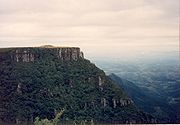
Paraná and Etendeka traps
Encyclopedia

Ponta Grossa
Ponta Grossa is a city in the state of Paraná, Brazil. With a population of over 315,000 inhabitants, it is the 4th most populous city of Paraná.It is the second industrial pole of the State, exceeded only by Curitiba—the State's capital and largest city...
, Paraná
Paraná (state)
Paraná is one of the states of Brazil, located in the South of the country, bordered on the north by São Paulo state, on the east by the Atlantic Ocean, on the south by Santa Catarina state and the Misiones Province of Argentina, and on the west by Mato Grosso do Sul and the republic of Paraguay,...
, Brazil
Brazil
Brazil , officially the Federative Republic of Brazil , is the largest country in South America. It is the world's fifth largest country, both by geographical area and by population with over 192 million people...
; and Etendeka plateau of SW Angola
Angola
Angola, officially the Republic of Angola , is a country in south-central Africa bordered by Namibia on the south, the Democratic Republic of the Congo on the north, and Zambia on the east; its west coast is on the Atlantic Ocean with Luanda as its capital city...
and NW Namibia
Namibia
Namibia, officially the Republic of Namibia , is a country in southern Africa whose western border is the Atlantic Ocean. It shares land borders with Angola and Zambia to the north, Botswana to the east and South Africa to the south and east. It gained independence from South Africa on 21 March...
) comprise a large igneous province
Large igneous province
A Large Igneous Province is an extremely large accumulation of igneous rocks—intrusive, extrusive, or both—in the earth's crust...
which includes both the main Paraná traps as well as the smaller severed portions of the flood basalt
Flood basalt
A flood basalt or trap basalt is the result of a giant volcanic eruption or series of eruptions that coats large stretches of land or the ocean floor with basalt lava. Flood basalts have occurred on continental scales in prehistory, creating great plateaus and mountain ranges...
s at the Etendeka traps in Namibia
Namibia
Namibia, officially the Republic of Namibia , is a country in southern Africa whose western border is the Atlantic Ocean. It shares land borders with Angola and Zambia to the north, Botswana to the east and South Africa to the south and east. It gained independence from South Africa on 21 March...
and Angola
Angola
Angola, officially the Republic of Angola , is a country in south-central Africa bordered by Namibia on the south, the Democratic Republic of the Congo on the north, and Zambia on the east; its west coast is on the Atlantic Ocean with Luanda as its capital city...
. The original basalt flows occurred 128 to 138 million years ago. The province had a post-flow surface area of 1.5 x 106 km² and an original volume projected to be in excess of 2.3 x 106 km³.
The basalt samples at Paraná and Etendeka have an age of about 132 Ma. It could be the origin of the Gough
Gough Island
Gough Island , also known historically as Gonçalo Álvares or Diego Alvarez, is a volcanic island in the South Atlantic Ocean. It is a dependency of Tristan da Cunha and part of the British overseas territory of Saint Helena, Ascension and Tristan da Cunha...
and Tristan da Cunha
Tristan da Cunha
Tristan da Cunha is a remote volcanic group of islands in the south Atlantic Ocean and the main island of that group. It is the most remote inhabited archipelago in the world, lying from the nearest land, South Africa, and from South America...
Islands as it is connected by the Walvis Ridge
Walvis Ridge
Walvis Ridge is an ocean ridge in the southern Atlantic Ocean, extending for thousands of miles, off the coast of southwest Africa. Both it and the Rio Grande Rise originated from hotspot volcanism now occurring at the islands of Tristan da Cunha , 300 kilometres east of the crest of the...
(Gough/Tristan hotspot
Tristan hotspot
The Tristan hotspot is a volcanic hotspot which is responsible for the volcanic activity which forms the volcanoes in the southern Atlantic Ocean. It is thought to have formed the island of Tristan da Cunha and the Walvis Ridge on the African Plate....
). The seamounts of the Rio Grande Rise (25°S to 35°S) go eastwards from the Paraná side. Sources are still unclear, however, this sight has been the subject of what may have been the single largest explosive volcanic eruption in Earth's history. Although it happened approximately 132 million years ago, evidence has suggested this catastrophic eruption of the long-extinct super volcano.

